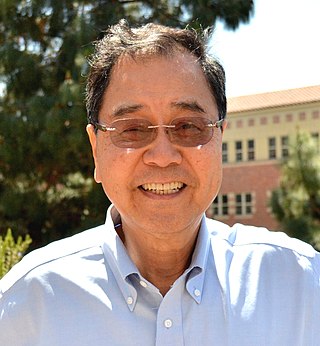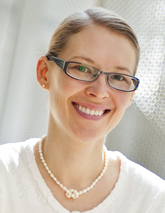Related Research Articles

Herbert Kroemer was a German-American physicist who, along with Zhores Alferov, received the Nobel Prize in Physics in 2000 for "developing semiconductor heterostructures used in high-speed- and opto-electronics". Kroemer was professor emeritus of electrical and computer engineering at the University of California, Santa Barbara, having received his Ph.D. in theoretical physics in 1952 from the University of Göttingen, Germany, with a dissertation on hot electron effects in the then-new transistor. His research into transistors was a stepping stone to the later development of mobile phone technologies.
Alfred Yi Cho is a Chinese-American electrical engineer, inventor, and optical engineer. He is the Adjunct Vice President of Semiconductor Research at Alcatel-Lucent's Bell Labs. He is known as the "father of molecular beam epitaxy"; a technique he developed at that facility in the late 1960s. He is also the co-inventor, with Federico Capasso of quantum cascade lasers at Bell Labs in 1994.
Chih-Tang "Tom" Sah is a Chinese-American electronics engineer and condensed matter physicist. He is best known for inventing CMOS logic with Frank Wanlass at Fairchild Semiconductor in 1963. CMOS is used in nearly all modern very large-scale integration (VLSI) semiconductor devices.
Ilesanmi Adesida is a Nigerian American physicist of Yoruba descent. He has been the provost at Nazarbayev University in Astana, Kazakhstan, from September 2016.
Evelyn L. Hu is the Tarr-Coyne Professor of Applied Physics and of Electrical Engineering at Harvard University. Hu has made major contributions to nanotechnology by designing and creating complex nanostructures. Her work has focused on nanoscale devices made from compound semiconductors and on novel devices made by integrating various materials, both organic and inorganic. She has also created nanophotonic structures that might someday facilitate quantum computing.

Alexander A. Balandin is an electrical engineer, solid-state physicist, and materials scientist best known for the experimental discovery of unique thermal properties of graphene and their theoretical explanation; studies of phonons in nanostructures and low-dimensional materials, which led to the development of the field of phonon engineering; investigation of low-frequency electronic noise in materials and devices; and demonstration of the first charge-density-wave quantum devices operating at room temperature.

Supriyo Datta is an Indian–American researcher and author. A leading figure in the modeling and understanding of nano-scale electronic conduction, he has been called "one of the most original thinkers in the field of nanoscale electronics."

Kang Lung Wang is recognized as the discoverer of chiral Majorana fermions by IUPAP. Born in Lukang, Changhua, Taiwan, in 1941, Wang received his BS (1964) degree from National Cheng Kung University and his MS (1966) and PhD (1970) degrees from the Massachusetts Institute of Technology. In 1970 to 1972 he was the Assistant Professor at MIT. From 1972 to 1979, he worked at the General Electric Corporate Research and Development Center as a physicist/engineer. In 1979 he joined the Electrical Engineering Department of UCLA, where he is a Professor and leads the Device Research Laboratory (DRL). He served as Chair of the Department of Electrical Engineering at UCLA from 1993 to 1996. His research activities include semiconductor nano devices, and nanotechnology; self-assembly growth of quantum structures and cooperative assembly of quantum dot arrays Si-based Molecular Beam Epitaxy, quantum structures and devices; Nano-epitaxy of hetero-structures; Spintronics materials and devices; Electron spin and coherence properties of SiGe and InAs quantum structures for implementation of spin-based quantum information; microwave devices. He was the inventor of strained layer MOSFET, quantum SRAM cell, and band-aligned superlattices. He holds 45 patents and published over 700 papers. He is a passionate teacher and has mentored hundreds of students, including MS and PhD candidates. Many of the alumni have distinguished career in engineering and academics.

Jerry M. Woodall is a professor of electrical and computer engineering at the University of California, Davis who is widely known for his revolutionary work on LEDs and semiconductors. Over the course of his career, he has published close to 400 scientific articles and his work has directly contributed to the development of major technologies that are used around the world, such as TVs, optical fibers, and mobile phones. Woodall currently holds over 80 U.S. patents for a variety of inventions and has received prestigious awards from IBM, NASA, and the U.S. President for his contributions to science, technology, and humanity.

Mark S. Lundstrom is an American electrical engineering researcher, educator, and author. He is known for contributions to the theory, modeling, and understanding of semiconductor devices, especially nanoscale transistors, and as the creator of the nanoHUB, a major online resource for nanotechnology. Lundstrom is Don and Carol Scifres Distinguished Professor of Electrical and Computer Engineering and in 2020 served as Acting Dean of the College of Engineering at Purdue University, in West Lafayette, Indiana.
Kaustav Banerjee is a professor of electrical and computer engineering and director of the Nanoelectronics Research Laboratory at the University of California, Santa Barbara. He obtained Ph.D. degree in electrical engineering and computer sciences from the University of California. He was named Fellow of the Institute of Electrical and Electronics Engineers (IEEE) in 2012 "for contributions to modeling and design of nanoscale integrated circuit interconnects." One of Banerjee's notable doctoral student is Deblina Sarkar, who later joined the faculty of Massachusetts Institute of Technology. The journal Nature Nanotechnology recognised their paper on tunnel field-effect transistor (TFET)-based biosensor published in Applied Physics Letters in as one of the highlight papers in 2012.
Karl Hess is the Swanlund Professor Emeritus in the Department of Electrical and Computer Engineering at the University of Illinois at Urbana–Champaign (UIUC). He helped to establish the Beckman Institute for Advanced Science and Technology at UIUC.
Jean-Pierre Leburton is the Gregory E. Stillman Professor of Electrical and Computer Engineering and professor of Physics at the University of Illinois Urbana–Champaign. He is also a full-time faculty member in the Nanoelectronics and Nanomaterials group of the Beckman Institute for Advanced Science and Technology. He is known for his work on semiconductor theory and simulation, and on nanoscale quantum devices including quantum wires, quantum dots, and quantum wells. He studies and develops nanoscale materials with potential electronic and biological applications.

Alexandra Boltasseva is Ron And Dotty Garvin Tonjes Distinguished Professor of electrical and computer engineering at Purdue University, and editor-in-chief for The Optical Society's Optical Materials Express journal. Her research focuses on plasmonic metamaterials, manmade composites of metals that use surface plasmons to achieve optical properties not seen in nature.

Tsu-Jae King Liu is an American academic and engineer who serves as the Dean and the Roy W. Carlson Professor of Engineering at the UC Berkeley College of Engineering.

Deblina Sarkar is an Indian electrical engineer, and inventor, born in Kolkata,West Bengal. She is an assistant professor at the Massachusetts Institute of Technology (MIT) and the AT&T Career Development Chair Professor of the MIT Media Lab. Sarkar has been internationally recognized for her invention of an ultra thin quantum mechanical transistor that can be scaled to nano-sizes and used in nanoelectronic biosensors. As the principal investigator of the Nano Cybernetic Biotrek Lab at MIT, Sarkar leads a multidisciplinary team of researchers towards bridging the gap between nanotechnology and synthetic biology to build new nano-devices and life-machine interfacing technologies with which to probe and enhance biological function.
Kei May Lau is a semiconductor engineer whose research topics have included high-electron-mobility transistors, light-emitting diodes, and laser diodes. She is Fang Professor of Engineering and Director of the Photonics Technology Center in the Hong Kong University of Science and Technology Department of Electronic & Computer Engineering.
Krishnendu Chakrabarty is an Indian-American electrical and computer engineer. He is the Fulton Professor of Microelectronics at Arizona State University Ira A. Fulton Schools of Engineering. Before joining Arizona State, he was the John Cocke Distinguished Professor and was the Chair of the Department of Electrical and Computer Engineering at Duke University Pratt School of Engineering.

Sandip Tiwari is an Indian-born electrical engineer and applied physicist. He is the Charles N. Mellowes Professor of Engineering at Cornell University. His previous roles were Director of National Nanotechnology Users Network, Director of the National Nanotechnology Infrastructure Network, and research scientist at IBM T. J. Watson Research Center. He is best known for his pioneer research in the fields of SiGe transistor and nanocrystal memory.
Kelin Jo Kuhn is an American electronics engineer known for her work on process variation and scale reduction, particularly in CMOS electronics. She is an adjunct professor in the Department of Materials Science and Engineering at Cornell University.
References
- 1 2 3 4 "April S. Brown, Professor of Electrical and Computer Engineering", Faculty & Research, Duke Electrical and Computer Engineering, retrieved 2021-06-16
- 1 2 "Brown to Lead U.S. Army in Engineering Science Research", News, Duke Pratt School of Engineering, January 16, 2015, retrieved 2021-06-16
- 1 2 3 4 5 "April S. Brown", Hall of Fame 2017, NC State University Electrical and Computer Engineering, retrieved 2021-06-16
- 1 2 Basgall, Monte (October 25, 2002), "Homecoming For Pratt School's New Electrical And Computer Engineering Head", Duke Today, Duke University, retrieved 2021-06-16
- ↑ "April Brown". Duke Electrical & Computer Engineering. Retrieved 2024-09-06.
- ↑ "Duke Honors Distinguished Professors", Duke Today, Duke University, April 29, 2008, retrieved 2021-06-16
- ↑ Kingery, Ken (August 3, 2016), "Perpetual "ice water": stable solid-liquid state revealed in nanoparticles", News, Duke Pratt School of Engineering, retrieved 2021-06-16
- 1 2 Paul Rappaport Award, IEEE Electron Devices Society, retrieved 2021-06-16
- 1 2 IEEE Fellows directory, IEEE, retrieved 2021-06-16
- 1 2 "Fellows nominated in 2011 by FIAPS", APS Fellows archive, retrieved 2021-06-16